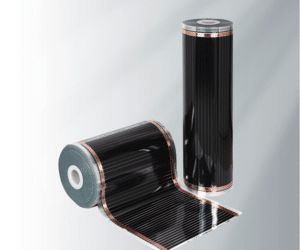Source: Internet
Table of Contents
ToggleGraphene’s thermal conductivity is a highly researched field, thanks to its exceptional heat conduction properties and potential applications in thermal management.
At room temperature, graphene’s thermal conductivity measures between 3000–5000 W/mK, significantly outperforming pyrolytic graphite, which has a thermal conductivity of around 2000 W/mK. However, some studies suggest this value may be overestimated, proposing that freely suspended graphene samples exhibit in-plane thermal conductivity closer to 2000–4000 W/mK. Despite this, graphene remains one of the best-known thermal conductors. Several studies indicate that graphene’s thermal conduction potential may even be theoretically infinite, depending on sample size—a phenomenon that defies traditional Fourier’s law of heat conduction at the microscale. Computer simulations and experiments reveal that larger graphene fragments can conduct more heat. Theoretically, graphene could absorb an unlimited amount of heat, with its thermal conductivity increasing logarithmically—a behavior attributed to its stable bonding structure and two-dimensional nature.
Given that graphene is more tear-resistant than steel while remaining lightweight and flexible, its thermal properties hold promising real-world applications.
But What Exactly Is Thermal Conductivity?
Thermal conductivity refers to the transfer of heat between objects of different temperatures through physical contact. Heat can be transferred via three mechanisms: conduction, convection, and radiation. Thermal conduction is commonplace in daily life—for example, warming hands with a hot water bottle. Heat flows from higher-temperature objects to lower-temperature ones.
At the molecular level, thermal conduction occurs when a surface absorbs thermal energy, causing particle collisions and electron movement within the material. These collisions transfer energy to neighboring particles until heat is fully dissipated. The process depends on the temperature gradient (difference in temperature), path length, and material properties.
Not all materials conduct heat well—metals are typically good conductors, whereas materials like wood or paper are poor conductors (insulators).
Exciting Applications of Graphene’s Thermal Conductivity
Graphene-driven thermal management holds immense potential in electronics, enabling efficient heat dissipation and optimized performance. In micro- and nanoelectronics, heat often limits the development of smaller, more efficient components. Thus, graphene’s superior thermal conductivity could revolutionize these applications.
Potential uses include:
-
Heat sinks
-
Thermal paste (used between microprocessors and heat sinks)
-
Graphene-based nanocomposites
Latest Developments in Graphene Thermal Conductivity
1. Graphmatech & Filalab Launch 3D-Printable Graphene Filament
Swedish material developer Graphmatech and Lithuanian filament manufacturer Filalab UAB introduced C-PETG, a graphene-enhanced filament. Marketed as one of the fastest ESD-safe polymer solutions, it supports printing speeds up to 120 mm/s while protecting sensitive components from static electricity.
2. Will iPhone 17 Use Graphene Cooling?
Reports suggest the iPhone 17 series (including iPhone 17, 17 Air, 17 Pro, and 17 Pro Max) may adopt a Vapor Chamber (VC) cooling system. It remains unclear whether some models will combine VC with graphene sheets or use one technology exclusively.
3. SmartIR’s Graphene Radiator Launches on SpaceX Falcon 9
Manchester University spin-off SmartIR announced its graphene-based adaptive radiator was launched aboard SpaceX’s Falcon 9, addressing thermal management challenges in space. Traditional satellites rely on power-hungry heaters or bulky thermal louvers, whereas SmartIR’s solution enables flexible heat regulation.
4. Graphene-Based Laser Lift-Off Enables Ultra-Thin Flexible Displays
Researchers from Seoul National University of Science and Technology, KAIST, and KIMM developed a graphene-assisted laser lift-off technique to separate ultra-thin OLED displays without damage. This breakthrough could enable stretchable, wearable electronics.
5. Laser-Induced Graphene (LIG) for Smart Space Suits
A team from KAIST, KIMM, and SEOULTECH demonstrated LIG technology, using femtosecond laser pulses to pattern graphene onto Kevlar. The resulting material serves as a multifunctional thermal regulator for space suits and telescopes, with applications in strain sensing and stray light absorption.
6. Zhejiang University’s Graphene Composite for Battery Thermal Management
Researchers at Zhejiang University developed a graphene-enhanced phase-change composite to prevent thermal runaway in lithium-ion batteries (LIBs). The material combines a graphene framework with paraffin, achieving high thermal conductivity and 90% latent heat retention—outperforming most existing composites.
7. Solidion’s Graphene-Based Fast-Charging Battery Cooling System
Solidion Technology patented a graphene-based solution that reduces LIB charging times to 5 minutes. This innovation could revolutionize EV charging, particularly in extreme temperatures.
Conclusion
These advancements highlight graphene’s rapidly evolving role in thermal management and high-performance applications, positioning it as a key material across multiple industries.
Note: Respect for originality—copyright of reprinted content belongs to the original authors. Contact us for removal if infringement occurs.
— Thanks for Reading —

